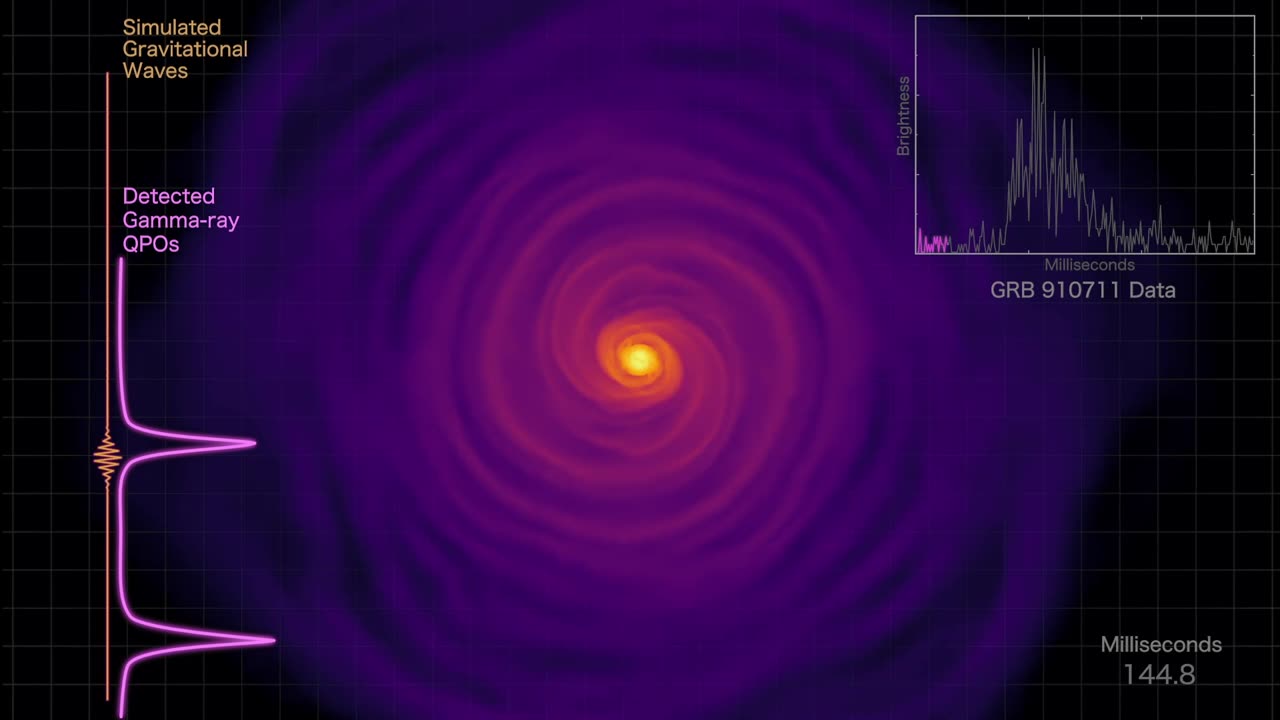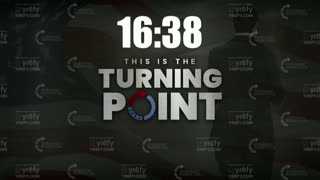Premium Only Content

Neutron Star Merger Simulation with Gamma-ray Observations
This animation follows the gravitational wave and density changes in a simulated neutron star merger and compares them to measurements of a short gamma-ray burst observed by NASA's Compton mission on July 11, 1991. Dark purple colors represent the lowest-density material, while yellow-white shows the highest. An audible tone and a visual frequency scale (at left) track the steady rise in the frequency of gravitational waves as the neutron stars close. When the objects merge at 19 seconds, the gravitational waves suddenly jump to frequencies of thousands of hertz and bounce between two primary tones. A magenta line appears at left to illustrate how quasiperiodic oscillations (QPOs) found in the gamma-ray emission correlate to those of the simulated gravitational waves. At the same time, a graph at upper right traces the changes in gamma-ray brightness observed during the same burst. To symbolize the ultimate formation of a black hole, a dot has been added at the center.
Credit: NASA's Goddard Space Flight Center and STAG Research Centre/Peter Hammond
Scott Wiessinger (KBRwyle) - Lead Producer
Francis Reddy (University of Maryland College Park) - Lead Science Writer
Cecilia Chirenti (University of Maryland, College Park) - Scientist
-
 3:02:41
3:02:41
TimcastIRL
8 hours agoABC REVIVES Jimmy Kimmel After TERROR Attack On Station, Sinclair REFUSES To Air Show | Timcast IRL
258K145 -
 2:32:12
2:32:12
The Charlie Kirk Show
8 hours agoTPUSA Presents This is The Turning Point Tour LIVE with Michael Knowles
136K61 -
 5:20:38
5:20:38
Drew Hernandez
12 hours agoDISNEY CUCKS FOR KIMMEL & ADDRESSING THE CHARLIE KIRK MEMORIAL AFTERMATH
58.1K19 -
 1:02:28
1:02:28
Flyover Conservatives
12 hours agoThe Most Overlooked Way to Fight Abortion (It’s Not Protests) - Robert Netzly; Why Triple-Digit Silver is Coming - Dr. Kirk Elliott | FOC Show
47.4K3 -
 1:55:33
1:55:33
Glenn Greenwald
11 hours agoDeceitful Hysteria over Tucker's Speech on Kirk; IDF Funder Larry Ellison to Take Over CBS, Paramount, and now TikTok; U.S. Embraces Leading Al-Qaeda Terrorist | SYSTEM UPDATE #519
211K99 -
 34:40
34:40
Donald Trump Jr.
12 hours agoWe Will Make Charlie Proud | TRIGGERED Ep.276
220K93 -
 1:01:49
1:01:49
BonginoReport
11 hours agoErika Kirk Forgives Charlie’s Assassin - Nightly Scroll w/ Hayley Caronia (Ep.139)
123K105 -
 1:54:19
1:54:19
megimu32
8 hours agoOn The Subject: Rush Hour | Would It Be Cancelled Today?
47.9K6 -
 1:24:12
1:24:12
Katie Miller Pod
10 hours ago $3.48 earnedEpisode 7 - Jillian Michaels | The Katie Miller Podcast
85.3K5 -
 13:09:57
13:09:57
LFA TV
1 day agoLFA TV ALL DAY STREAM ! | MONDAY 9/22/25
245K49